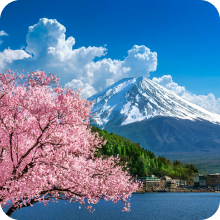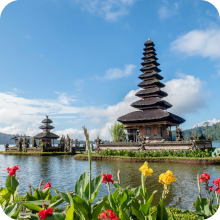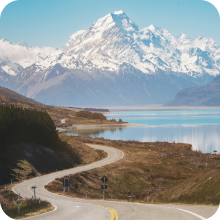Top-Rated Hot Springs in Japan: Discover Japan’s Best Onsens
Japan, the land of the rising sun, is also the land of relaxing hot springs, known as onsen. These natural baths, heated by the geothermal activity beneath Japan’s mountainous terrain, are a beloved part of Japanese culture. Whether you're soaking up the views of snow-capped mountains or unwinding in a forest retreat, Japan's hot springs offer a unique blend of relaxation and cultural immersion. In this guide, we’ll dive into the top-rated hot springs across Japan, along with everything you need to know to make your onsen experience unforgettable.
Understanding Onsen Culture in Japan
What is an Onsen?
An onsen is more than just a hot spring; it's a deeply ingrained part of Japanese culture. The waters are rich in minerals, believed to offer therapeutic benefits that range from relieving muscle pain to improving skin condition. Onsens come in various types, including sulfur, iron, and alkaline, each with its own unique benefits and characteristics.
Before you dive in—literally—it's crucial to understand onsen etiquette. Japanese onsen culture emphasizes cleanliness and respect. Bathers must wash thoroughly before entering the communal bath. Also, while nudity is the norm in most onsens, modesty towels are provided to help you feel comfortable. And remember, no splashing around—this isn’t your typical swimming pool.
The Health Benefits of Onsen Bathing
Onsens are not just about relaxation; they’re also about rejuvenation. The mineral-rich waters can help soothe aching muscles, improve circulation, and even alleviate certain skin conditions. Sulfur springs, for example, are known for their detoxifying properties, while iron-rich springs can help improve blood circulation. Soaking in these natural hot tubs isn’t just a luxury—it’s a health boost.
The Best Onsen Regions in Japan
Hakone: The Gateway to Onsen Heaven
Just a stone’s throw from Tokyo, Hakone is one of Japan’s most accessible and popular onsen destinations. Nestled in the shadow of Mount Fuji, this region offers a mix of traditional and modern onsen experiences. For a family-friendly adventure, Yunessun offers themed baths (think coffee, wine, and green tea baths), while Tenzan Onsen provides a more traditional setting with its serene outdoor baths.
Hakone’s allure doesn’t end with its hot springs. The region is also home to beautiful landscapes, museums, and the scenic Hakone Ropeway, making it the perfect blend of relaxation and exploration.
Beppu: The Hot Spring Capital of Japan
If onsens had a capital, it would be Beppu. Located on the island of Kyushu, Beppu boasts the highest concentration of hot springs in Japan. The city is famous for its “hells” (jigoku), which are not for bathing but rather for admiring—these geothermal wonders range from boiling mud pools to vibrant, colored ponds.
For a more traditional soak, Hyotan Onsen is a must-visit. It’s a large, well-maintained onsen with a variety of baths, including sand baths where you can be buried up to your neck in warm, soothing sand. Takegawara Onsen, one of the oldest in Beppu, offers a nostalgic experience with its classic wooden architecture and indoor baths.
Noboribetsu: Hokkaido’s Premier Hot Spring Resort
Up in the northern island of Hokkaido, Noboribetsu stands out as a premier onsen destination. The volcanic landscape here, particularly Jigokudani (Hell Valley), adds a dramatic backdrop to your onsen experience. The mineral-rich waters of Noboribetsu’s onsens are among the most potent in Japan, drawing visitors seeking therapeutic benefits.
Dai-ichi Takimotokan is one of the top choices in Noboribetsu, offering a variety of baths with stunning views of the surrounding nature. For those looking to combine their onsen visit with a bit of sightseeing, Noboribetsu’s Hell Valley is a must-see, where you can witness the raw geothermal power that fuels the region’s hot springs.
Kusatsu: Japan’s Most Famous Hot Spring Town
Kusatsu, located in Gunma Prefecture, is perhaps Japan’s most famous hot spring town. The town’s Yubatake (hot water field) is a spectacular sight and a central feature of Kusatsu. The waters here are highly acidic, which is believed to kill bacteria and promote healing—don’t worry, it’s perfectly safe for bathing!
Sainokawara Rotenburo is one of Kusatsu’s top outdoor baths, offering a large open-air bath surrounded by natural beauty. After your soak, take a stroll around the town to enjoy the traditional performances and local shops that give Kusatsu its charming atmosphere.
Kurokawa Onsen: A Hidden Gem in Kyushu
For a more rustic and intimate onsen experience, head to Kurokawa Onsen in Kumamoto Prefecture. This charming village offers a retreat into nature, with many ryokans (traditional inns) offering access to outdoor baths surrounded by lush forests and tranquil rivers.
Yamamizuki and Hozantei are among the most renowned onsens in Kurokawa, known for their serene settings and beautiful rotenburo (outdoor baths). Kurokawa’s onsen-hopping pass, which allows you to visit multiple baths in the area, is a great way to experience the variety of hot springs available here.
Thanks for visiting our blog, are you planing to travel to Japan? Check out our eSIM Japan.

Unique Onsen Experiences in Japan
Mixed-Gender and Private Onsens
While most onsens are gender-separated, konyoku (mixed-gender baths) still exist in some parts of Japan. These baths provide a rare opportunity for couples and families to enjoy the onsen experience together. Places like Takaragawa Onsen in Gunma offer expansive mixed-gender outdoor baths set in breathtaking natural surroundings.
If privacy is a priority, many onsens offer kashikiri (private baths) where you can enjoy the hot springs in solitude or with a partner. These private onsens are ideal for those who may feel uncomfortable with communal bathing or simply want a more intimate experience.
Themed and Unusual Onsens
Japan’s creativity knows no bounds, even when it comes to onsens. Themed hot springs, like those at Hakone Kowakien Yunessun, offer a quirky twist on the traditional onsen experience. Imagine soaking in a wine bath, or perhaps a green tea bath—yes, these are real options!
For those who enjoy a bit of novelty, these unusual onsen experiences provide a fun way to enjoy Japan’s hot springs while adding a unique element to your travel stories. It’s not every day you get to say you’ve bathed in coffee!
Planning Your Onsen Trip
Best Times of Year to Visit Japanese Hot Springs
While onsens are enjoyable year-round, the experience can vary greatly depending on the season. Winter is arguably the most magical time to visit, especially in regions like Hokkaido, where you can soak in an outdoor bath surrounded by snow. Spring offers the chance to enjoy cherry blossoms while bathing, while autumn brings vibrant foliage to frame your onsen experience.
It’s also important to consider the crowds. Peak times, such as Golden Week or New Year’s, can see onsens packed with locals and tourists alike. For a more tranquil experience, try visiting during off-peak seasons or weekdays.
Combining Onsen Visits with Sightseeing
Onsens are often located in regions that are rich in natural beauty and cultural attractions, making it easy to combine relaxation with exploration. For example, a trip to Hakone isn’t complete without a cruise on Lake Ashi or a visit to the Hakone Open-Air Museum. In Beppu, the hells and local cuisine are must-try experiences alongside your onsen visit.
When planning your itinerary, balance onsen visits with sightseeing to fully appreciate what each region has to offer. Whether it’s a day trip from Tokyo or a multi-day adventure in Kyushu, there’s no shortage of activities to complement your onsen relaxation.
Onsen Etiquette and Tips for First-Time Visitors
What to Expect During Your Onsen Experience
For first-time visitors, the onsen experience can be a bit daunting, but it’s easy to get the hang of it. Upon arrival, you’ll usually change into a yukata (a casual kimono) and head to the washing area, where you’ll need to scrub thoroughly before entering the bath. Cleanliness is paramount, so take your time to ensure you’re squeaky clean.
Once in the bath, relax and soak in the mineral-rich waters. Keep in mind that talking is usually kept to a minimum to maintain a peaceful atmosphere. After your soak, many onsens offer a relaxation area where you can unwind with a cool drink or a light snack—an ideal way to finish your onsen experience.
Health and Safety Considerations
While onsens are generally safe, there are a few health considerations to keep in mind. The high temperatures of the baths can be intense, so avoid staying in too long if you’re not used to it. Make sure to stay hydrated before and after your bath, and if you have any medical conditions—particularly heart-related—consult with a doctor beforehand.
Tattooed travelers may encounter restrictions at some onsens, as tattoos are often associated with the yakuza (Japanese organized crime) in Japan. However, this is slowly changing, and more onsens are becoming tattoo-friendly or offering private baths as an alternative.
Before you take off make sure to check with local government of the travel status.
FAQs
Do I need to book in advance to visit a hot spring in Japan?
It depends on the onsen. While some require advance reservations, especially during peak seasons, many are open for walk-ins.
Can I visit an onsen if I have tattoos?
Some onsens have strict no-tattoo policies, but many now allow tattoos or offer private baths. Always check the specific onsen’s rules beforehand.
What should I bring to an onsen?
Most onsens provide towels and toiletries, but you may want to bring your own for comfort. It’s also advisable to bring a change of clothes and a water bottle.
Are there hot springs suitable for families with children?
Yes, many onsens are family-friendly, offering private baths and facilities suitable for children. Some even have special areas for kids.
Is it safe to use onsen if I have a heart condition?
While onsen bathing is generally safe, individuals with heart conditions or other health concerns should consult a doctor before visiting. Avoid staying in hot water for too long and stay hydrated.









